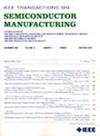基于柔性交货期优化模型的半导体晶圆制造设备产能评估
IF 2.3
3区 工程技术
Q2 ENGINEERING, ELECTRICAL & ELECTRONIC
引用次数: 0
摘要
本文研究半导体晶圆制造厂的生产能力估计问题。产能评估包括在考虑产品组合和目标周期时间的情况下,在给定的规划范围内确定晶圆制造设施的最大可实现吞吐量。晶圆制造设施(fab)是最复杂的生产系统之一,包括每个产品的数百个工艺步骤以及数千台加工机器和可重复进入的工艺流程,其中产品必须多次访问同一个工作中心。在这方面,通过模拟晶圆制造过程来估计生产能力是一个具有挑战性的问题。为了正确地捕捉过程的动态,我们提出了一个灵活的基于前置时间的优化模型,该模型考虑了在制品(WIP)随时间的状态以及WIP水平与前置时间之间的关系。实际实例的仿真实验结果表明了该模型相对于现有模型的优越性。本文章由计算机程序翻译,如有差异,请以英文原文为准。
Capacity Estimation for Semiconductor Wafer Fabrication Facilities via an Optimization Model Based on Flexible Lead Times
In this paper, we consider the problem of production capacity estimation for a semiconductor wafer fabrication facility. Capacity estimation involves determining the maximum achievable throughput of a wafer fabrication facility during a given planning horizon in consideration of both product mix and target cycle time. The wafer fabrication facility (fab) is one of the most complex production systems, consisting of hundreds of process steps for each product as well as thousands of processing machines and re-entrant process flows wherein products must visit the same workcenter multiple times. In this regard, estimating production capacity by modeling the wafer manufacturing process is a challenging problem. To properly capture the dynamics of the process, we propose a flexible-lead-time-based optimization model that considers both the state of work-in-process (WIP) over time and the relationship between WIP levels and lead times. The results of simulation experiments using a real-sized instance demonstrate the advantages of the proposed model over existing alternatives.
求助全文
通过发布文献求助,成功后即可免费获取论文全文。
去求助
来源期刊

IEEE Transactions on Semiconductor Manufacturing
工程技术-工程:电子与电气
CiteScore
5.20
自引率
11.10%
发文量
101
审稿时长
3.3 months
期刊介绍:
The IEEE Transactions on Semiconductor Manufacturing addresses the challenging problems of manufacturing complex microelectronic components, especially very large scale integrated circuits (VLSI). Manufacturing these products requires precision micropatterning, precise control of materials properties, ultraclean work environments, and complex interactions of chemical, physical, electrical and mechanical processes.
 求助内容:
求助内容: 应助结果提醒方式:
应助结果提醒方式:


